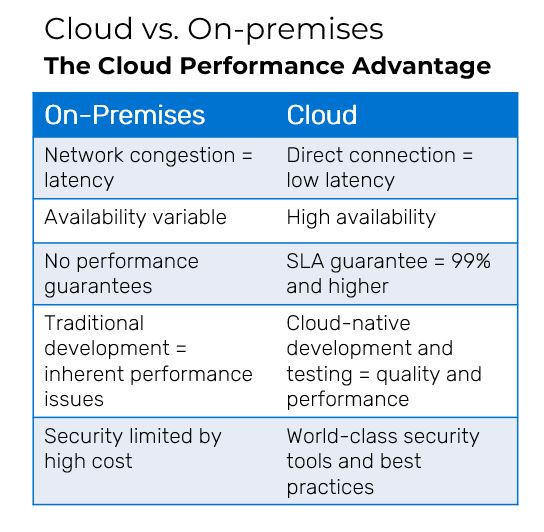
How Cloud Improves Application Performance
In the digital world, a consistent, high-performance user experience for clients, interconnected business partners and employees is a mission-critical business imperative. Negative user experiences can result in lost revenue and damage brand reputation. In addition, a diminished user experience for employees can hinder your company’s productivity.
Cloud computing is an effective solution to these challenges. Cloud offers multiple advantages to significantly increase your application performance, including low latency, high availability, scalability and a high level of security.
Direct Connections to Cloud Ensure Low Latency

One of the greatest obstacles to the digital experience is network latency, which slows application response time. Demonstrating the consequences of this problem, a 2023 survey by Digital.com found that 53% of online shoppers expect e-commerce pages to load in three seconds or less, and half will abandon shopping carts if pages don’t load fast enough.1 Looka, a design firm specializing in logo development, points out that "Google considers page speed a factor in overall page quality," which will impact ranking, a never-ending challenge for digital businesses.
Low latency is essential to a consistent user experience and deploying an application in the cloud can help. According to PwC’s 2023 Cloud Business Survey, 92% of cloud-powered companies say cloud has enhanced the user experience.2
Bypassing the public internet with a direct connection to the cloud is the most reliable way to achieve low latency.
Physical proximity is an underlying factor. The closer the application is to the user, the lower the latency. Leveraging a direct connection to one of the leading cloud services providers – with physical locations around the world – enables you to deploy applications closer to your end users, substantially reducing latency.
Cloud Providers Guarantee High Availability
Business continuity is a top business driver for cloud, according to Foundry’s 2022 Cloud Computing research.3 This is because cloud maintains high availability for applications. By distributing workloads across clusters of multiple servers, eliminating single points of failure, the cloud keeps your applications always available to users. The cloud is architected to be fault-tolerant and backed by redundancy and disaster recovery capabilities.
The best part may be that you get these assurances in writing. Hyperscalers – like Google Cloud, Microsoft Azure, Oracle Cloud and AWS – offer service-level agreements (SLAs) that promise a certain level of uptime, usually 99% and above. With direct connections to all these hyperscalers, CoreSite can offer 100% uptime SLA.
Cloud Scalability Meets User Demand
Scalability is critical for applications that experience massive growth in demand, as well as unpredictable or seasonable surges in traffic. Without the right amount of computing resources, an application will crash and disrupt the user experience.
Scalability is one of the most appealing advantages of the cloud. Scaling on-prem resources – which necessitates purchasing and manually installing additional hardware – can be costly, slow and disruptive. Conversely, cloud infrastructure is built to achieve a level of scaling that most organizations could not attain cost-effectively. Scaling applications in the cloud often can be done with just a few clicks, and the process even can be automated.
How Cloud Impacts Application Development
Building applications in the cloud also enhances performance. Cloud-native development empowers software engineers to design applications to run in the cloud, with greater scalability, resiliency and reliability.
In addition, testing can be streamlined and automated in the cloud, so software can be tested much more thoroughly every time a change is made to the code. Testing in the cloud also enables developers to analyze real-world application behavior on a variety of devices, to catch bugs that might otherwise go undetected. Eliminating defects improves quality and has a direct effect on the user experience.
Strong Cloud Security Keeps Applications Running
Although cybersecurity is not the first topic that comes to mind with regard to application performance, the reality is that security vulnerabilities can quickly translate into devastating performance issues. For example, a distributed denial-of-service (DDoS) attack can overload your application with counterfeit traffic and make it inaccessible to the actual users.
The cloud can protect your application from these security hazards, however. Analyst firm Gartner states, “Cloud computing is always more secure than on-premises.”4 Employing a wide range of world-class security tools and best practices, the top cloud companies are able to provide much stronger security than most organizations can afford in an in-house infrastructure. In addition, using a direct connection to the cloud enables you to route data over a private network, avoiding the public internet and its countless security threats.
Application Performance in Cloud Computing: The Right Choice
The cloud can boost application performance, compared to your on-premises infrastructure, but it all depends on the path you take to the cloud. Offering direct connections to all the major cloud providers, CoreSite provides a native cloud onramp that delivers low latency, high availability and security to produce maximum cloud application performance.
References
- 1 in 2 visitors abandon a website that takes more than 6 seconds to load, Digital.com
- PwC’s 2023 Cloud Business Survey, PwC
- Cloud computing study 2022, Foundry
- The Future of Cloud Computing in 2027: From Technology to Business Innovation, Gartner










